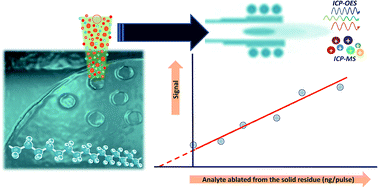Quantitative elemental analysis of polymers through laser ablation – inductively coupled plasma by using a dried droplet calibration approach, DDCA
Abstract
The so-called Dried Droplet Calibration Approach (DDCA) was applied for the first time to the determination of elemental concentration in polyethylene and polypropylene samples by means of inductively coupled plasma optical emission spectrometry (ICP-OES) and mass spectrometry (ICP-MS). Based on this novel calibration strategy, small volumes (c.a., 1 μL) of a series of multielemental aqueous standard solutions were deposited on the sample solid surface. Afterwards, the droplets were dried and a significant fraction of the remaining solid residues (i.e., 80% of their surface area) was ablated. The integrated signals were plotted against the mass of added analyte ablated per laser shot. The analyte concentration in the sample was obtained by extrapolation of the obtained calibration lines. A study demonstrating the existence of matrix effects was carried out, and it was noticed that carbon was not an appropriate internal standard because it did not compensate for changes in the absolute amount of ablated material as a function of the sample matrix. In contrast, elements such as Sc and Y mitigated this effect. External calibration using a polymeric support also proved to be inefficient from the point of view of accuracy. In contrast, the DDCA presented as an outstanding feature the compensation for matrix effects, because with this method both the sample and added standard were simultaneously ablated, and the generated aerosols reached the plasma together. The accuracy of the DDCA was demonstrated by means of the analysis of three polymer certified reference materials. It was verified that, in general terms, there were not significant differences between the elemental certified concentrations and those obtained by applying the DDCA. Furthermore, three polyethylene and three polypropylene samples were analyzed following both the DDCA and a reference method based on acid digestion and further ICP analysis. Both methodologies provided similar results for Al, Ti, Si, Cr, Ca, Zn and Mg. For elements either potentially volatile or present at low concentrations such as As, Hg and Ti in some polymers, there were significant discrepancies between certified and measured values.



 Please wait while we load your content...
Please wait while we load your content...